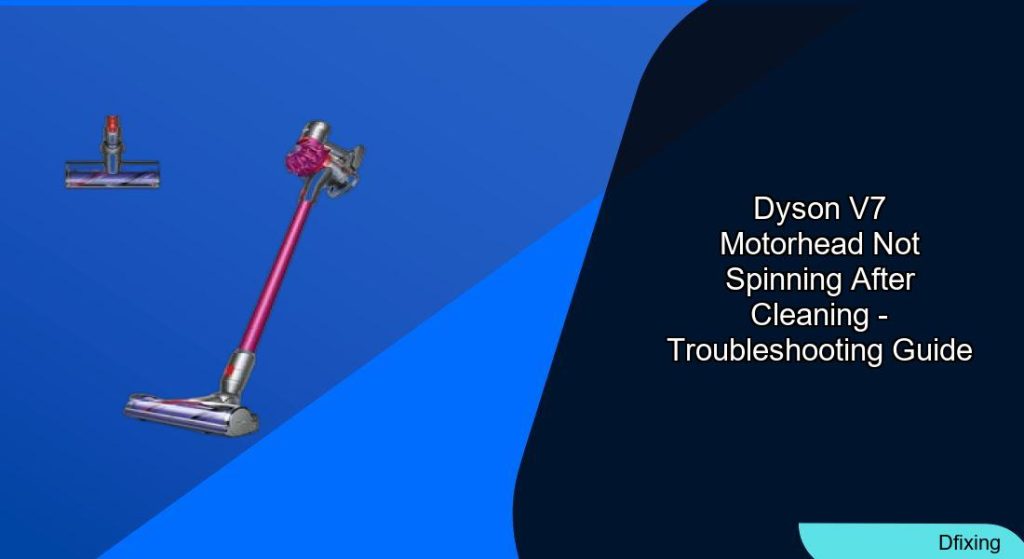The Dyson V7 vacuum cleaner is a powerful tool for maintaining clean carpets and floors, but users often face frustration when the motorhead brush bar stops spinning—even after thorough cleaning. This issue can lead to reduced suction, poor dirt pickup, and inefficient cleaning. The problem typically stems from blockages, wear and tear, or electrical faults. This guide breaks down the causes, provides actionable solutions, and offers maintenance tips to keep your Dyson V7 running smoothly.
Affiliate disclosure: As an Amazon associate, We'll earn a commission for every successful order through our affiliate links in the article. However, you won’t be charged anything for this.
By exploring common culprits like tangled debris, faulty motors, and clogged gears, this article will walk you through step-by-step fixes. Whether you’re dealing with a sudden malfunction or recurring issues, you’ll learn how to diagnose and resolve the problem independently or know when to seek professional help. Let’s dive into the most frequent causes and their remedies.
Common Causes of a Non-Spinning Motorhead and Their Solutions
Blocked Brush Roll or Gear Mechanism
Hair, threads, or small objects often wrap around the brush roll or gear, preventing rotation. To fix this:
1. Turn off and unplug the vacuum.
2. Remove the brush roll cover and inspect for debris.
3. Use scissors to cut tangled items and a brush to clear particles.
4. Check the gear mechanism at the motorhead’s end for obstructions and clear them with a screwdriver or tweezers.
5. Reassemble and test the brush bar.
Worn-Out Brush Roll
Frayed bristles or damaged brush rolls reduce effectiveness. Replace the brush roll every 6-12 months, depending on usage. Purchase a Dyson-branded or compatible third-party part, and follow the manufacturer’s installation instructions.
Faulty Motor or Electrical Connections
If the motor hums but the brush bar doesn’t spin, inspect:
– Electrical Contacts: Clean dirty or corroded contacts with a cotton swab dipped in rubbing alcohol.
– Internal Wiring: Check for frayed wires and replace if necessary.
– Motor Function: If the motor fails to power the brush bar, contact Dyson support for repair options.
Partial Airway Blockage
A pulsating vacuum or sudden shutdowns may indicate a clogged airway. Remove the dust bin and clean the bin inlet’s flap. Use compressed air or a wooden skewer to clear debris from the brush head.
Step-by-Step Troubleshooting for Motorhead Issues
Detailed Cleaning Process
- Disassemble the Head: Unplug the vacuum and detach the motorhead.
- Clean Electrical Contacts: Locate the metal contacts on the head and vacuum body. Wipe them with a soft cloth or alcohol-dipped cotton swab.
- Inspect the Gear and Brush Bar: Remove the brush bar, then clear hair or debris from the gear mechanism. Manually spin the gear to ensure smooth movement.
- Check Internal Cavities: Use a screwdriver to press the white tab and remove the dust filter. Clear hair and debris from the internal cavity using a T8 Torx screw.
- Reassemble and Test: Reinstall all components and test the brush bar’s rotation.
When to Contact Dyson Support
If DIY fixes fail, Dyson’s warranty may cover replacement parts. Contact their support team:
– US: 866-693-9766
– UK: 0800-298-0298
– CA: 1-877-397-6622
– AU: 1800 239 766
– NZ: 0800 397 667
Preventative Maintenance Tips
Regular Cleaning Routine
- After Each Use: Wipe the brush bar and remove loose debris.
- Monthly Deep Clean: Disassemble the motorhead to clean gears, electrical contacts, and internal cavities.
Proper Storage
- Store the vacuum in a dry, dust-free area.
- Keep the cord neatly coiled to avoid kinks or damage.
Optimize Usage
- Adjust the floor type setting for carpets versus hard floors.
- Empty the dust bin before it reaches capacity to maintain airflow.
Filter Maintenance
- Clean the main filter with water every 3-6 months, ensuring it dries completely.
- For V6 models, disassemble the handle to clean the rear foam filter.
Evaluating DIY Repairs for Motorhead Problems
Pros
- Cost-Effective: Save on repair fees.
- Quick Fixes: Resolve issues immediately without waiting for service.
- Skill Development: Learn your vacuum’s mechanics for future troubleshooting.
Cons
- Risk of Damage: Incorrect handling may worsen the issue.
- Warranty Risks: Opening the motorhead could void coverage.
- Time-Intensive: Complex fixes require patience and precision.
Frequently Asked Questions (FAQ)
How do I clean the electrical contacts on my Dyson V7 motorhead?
Turn off the vacuum, detach the head, and locate the metal contacts. Gently wipe them with a cotton swab soaked in rubbing alcohol. Ensure they’re dry before reassembly.
Why does my brush bar spin briefly then stop?
This often signals worn internal wiring or a clogged gear mechanism. Inspect wiring for fraying and clear debris from the gear.
Can a clogged airway cause the motorhead to stop spinning?
Yes. A partial blockage triggers pulsating operation. Check the bin inlet flap and use compressed air to clear the brush head.
How often should I replace the brush roll?
Replace every 6-12 months, depending on usage frequency and wear.
What tools are needed for deep cleaning?
Scissors, cotton swabs, rubbing alcohol, a T8 Torx screwdriver, and compressed air.
Conclusion
A non-spinning Dyson V7 motorhead can be resolved with systematic troubleshooting. By addressing blockages, worn parts, or electrical issues, you can restore optimal performance. Regular maintenance minimizes future problems, while DIY repairs offer cost savings—though caution is advised to avoid warranty pitfalls. If independent fixes don’t work, Dyson’s support team can provide warranty-backed solutions. With these steps, your V7 will return to peak efficiency, ensuring clean carpets and hassle-free operation.







